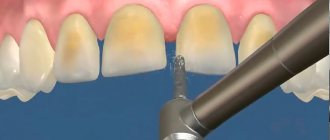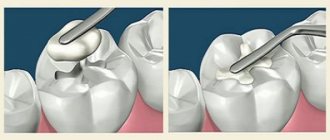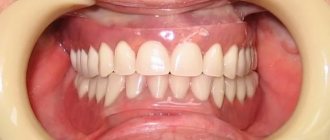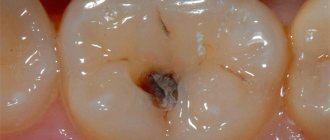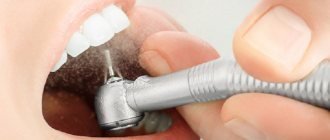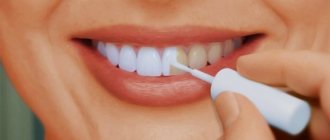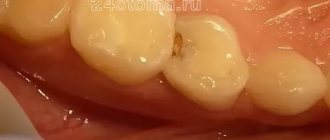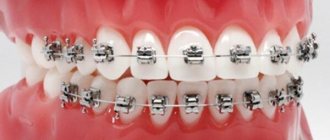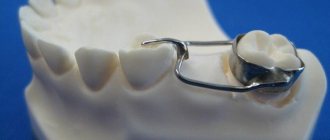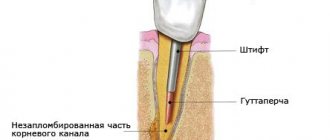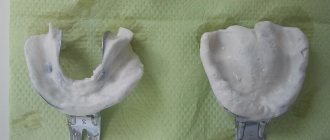- Dental crown - what is it?
- Types, materials, manufacturing methods and photos of dental crowns
- Time and stages of making dental crowns
- Lifespan of dental crowns
- How to best prepare for a visit to a dentist or orthopedist
- Before visiting an orthopedic dentist
- At the dentist's appointment
- After prosthetics
- Which crown is better - metal-ceramic or zirconium?
- Common questions from clients
- About cheap dental crowns, advice
Dental crown - what is it?
A dental crown is a structure that replaces or restores the coronal part of a tooth.
By analogy, the crown can be compared to a soldier’s helmet. A crown on a tooth covers its upper part, like a helmet, on a soldier's head. A dental crown has three main functions:
- Aesthetic (visually retains an appearance indistinguishable from your own teeth)
- Functional (promotes chewing, as it is fully capable of withstanding and distributing the chewing load in full.)
- Protective (preserves the tooth’s own tissues from mechanical and carious damage)
Why do you need to cover (restore) teeth with crowns?
- Tooth decay is the most common reason for crowning. If the coronal part of the tooth is destroyed by more than 50% or the presence of circular caries, restoration of the coronal part of the tooth with an orthopedic crown is indicated. If this rule is not followed, unfortunately, within several years the tooth is destroyed and further restoration is not possible (the tooth will be removed).
- Depulped (nerves have been removed from the teeth) chewing teeth should be covered with orthopedic crowns to avoid chips and fractures of the walls of the crown part of the tooth. The thing is that when depulping (removing the nerve of a tooth), in addition to the nerve, the entire nutrient bundle is removed. In other words, the tooth does not receive nutrition and the materials used to fill the root canal have a strong drying effect on the tooth tissue, that is, they dry out the tooth, and therefore the tooth becomes very fragile.
- Aesthetic defects, such as dental discoloration due to fluorosis, enamel hypoplasia, tetracycline teeth, etc., require restoration through the manufacture of crowns.
- Injuries, in case of traumatic damage to the coronal part of the tooth (fracture, chipped tooth crown), there is often a need for restoration with an orthopedic crown.
- The need for total or partial jaw prosthetics. That is, if it is necessary to replace part of the missing teeth or correct dentofacial deformations, the supporting teeth are covered with crowns, which are part of bridge or splinting prostheses.
- Also, if we are talking about removable dentures, then the supporting teeth are covered with crowns to avoid mechanical damage from excess pressure from the removable denture.
Why depulpate teeth before dentures?
Before prosthetics, the dentist must grind (remove part of the dentin and enamel) the tooth by 1.5 - 2 mm (depending on the material of the future crown) around the circumference. It is impossible to maintain absolute sterility during this process, due to the fact that the oral cavity is not sterile. Therefore, by leaving your teeth “alive” you preserve microbes in your tooth, and over time (from several months to several years) the problem will make itself known and the tooth will have to be removed.
Cement for dental crowns and dentures
In dentistry, cement means not only the natural material that covers the root of the tooth, but also the artificial material with which dentures, crowns and veneers are attached. Artificial cement for crowns is used for their permanent fixation; it is constantly in the patient’s mouth and therefore should be as close to natural as possible. It should not affect the dental pulp or injure the soft tissues of the oral cavity, and should not dissolve in saliva or shrink during use.
Therefore, in modern dentistry, only those materials are used that best meet the requirements.
Denture cement is also called dental glue, because it is used to glue not only crowns and bridges to teeth, but also veneers, lumineers, and other dental structures, the main purpose of which is to give the patient a snow-white Hollywood smile.
Types, materials, manufacturing methods and photos of dental crowns:
In modern dentistry, metal-ceramic crowns and crowns based on zirconium dioxide are most often used.
Crowns such as solid-cast and stamped are made extremely rarely and mainly in cases where it is impossible or impractical to manufacture metal-ceramic or zirconium crowns.
- Metal-ceramic crowns
They are a combined crown, where the frame (cap) is made of metal, which is later covered with ceramic mass. Aesthetically and functionally, it is practically no different from your own dental tissues. - Crowns based on zirconium dioxide (zirconium)
They are a combined crown, where the frame (cap) is made of zirconium (in other words, a white mineral) which is later covered with ceramic mass. Aesthetically and functionally, it is practically no different from your own dental tissues. Zirconium crowns are more aesthetic due to increased transparency. - Temporary crowns (metal-plastic crowns)
They are made of either composite or plastic. These crowns are slightly inferior in beauty and strength to the above. But they have a huge advantage - they can be made in a matter of minutes right in the dentist’s office. They are used as an intermediate (protective) structure during the production of permanent crowns.
Structure
The structure of primary and secondary cements is different.
- Primary (acellular) consists mainly of collagen fibers, as well as an amorphous adhesive substance.
- The secondary (cellular) structure is similar to coarse-fiber bone, only without blood vessels, and contains mainly cementocytes, cementoblasts and intercellular substance.
Unlike real bone tissue, cement is nourished diffusely through the periodontium. The chemical composition consists of organic substances, which make up 32%, and inorganic substances, which make up 68%.
Time and stages of making dental crowns
To make permanent dental crowns, the dentist will require an average of a week and 2-3 patient visits.
- First visit The doctor conducts a functional analysis. Then the teeth are prepared (depending on the type of dental crown). Takes silicone impressions. Makes and fixes temporary crowns on prepared teeth. Determines the color of future teeth together with the patient. Discusses options for crown shapes.
- Second visit (after 7 days) Trying on the finished structure in the oral cavity. Fixation of the crown with double-hardening cement. If the shape or color needs to be adjusted, another visit to the dentist may be required. Metal-ceramic and zirconium crowns are made in a dental laboratory within 7-12 days (depending on the complexity of the work). More than 5 dental technicians are involved in the process.
We strongly do not recommend using advertising products “dental crowns in an hour”, etc.
Unfortunately, technically, modern CAD CAM systems do not reach the level that a dental technician can make (either aesthetically or functionally) the marginal fit of such crowns, and the aesthetic appearance does not stand up to criticism.
What is a dental crown?
A dental crown is a non-removable dental prosthesis in the form of a single element, a kind of “cap”, which is made from impressions in a dental laboratory and then attached to the tooth. In this way, the crown, or visible part of the tooth is replaced if it is severely damaged, missing or has a serious aesthetic defect. Crowns will be required in order to fix a bridge or clasp prosthesis on supporting teeth, which may be completely healthy. You can “crown” not only a damaged natural tooth, but also, in the case of its complete absence, a dental implant.
The question of installing a crown usually arises if the crown part of the tooth is destroyed by more than 70%. In this case, you can forget about filling or microprosthetics with an inlay. They will not provide optimal redistribution of the chewing load. In the future, this threatens that improper pressure on the tooth will lead to its splitting and inevitable subsequent removal. Therefore, the choice between a filling, an inlay and a crown should be based solely on the indications.
What teeth are crowns placed on?
As a rule, crowns are installed on the lower and upper teeth without any fundamental differences; only the part that matters is the anterior or chewing one. For the smile zone, aesthetics is an important criterion for the quality of prosthetics. The prosthesis must be absolutely identical to natural teeth. In such cases, a crown made of solid ceramics or based on zirconium dioxide is placed. The main criterion for choosing structures for the chewing group is the strength possessed by metal, metal-ceramic and zirconium crowns. The crown on the wisdom tooth is fixed if the figure eight is in the correct position and is involved in chewing or is necessary to secure the clasp prosthesis.
Indications for installation of dental crowns
- Carious lesions in more than 50% of tissues;
- Aesthetic problems - large chips and cracks, discoloration;
- Fracture of the coronal part;
- Pathological abrasion of enamel.
Before visiting an orthopedic dentist
- Do not be nervous.
- Before taking (an hour), eat a hearty meal (the process of digesting food reduces strong emotional arousal).
- Try to plan your first visit to an orthopedic dentist for the first half of the day while it is light (only natural light allows you to accurately determine the color of your teeth), before the doctor is tired (we are all human, and in the first half of the day the doctor will pay you more attention and time than in the evening), while you not tired (the patient’s understanding of the process and all stages of treatment is very important).
- Collect all the photographs of your teeth that were taken before (regardless of the statute of limitations), this is often necessary.
- If you have old dental crowns or dentures, you should also take them with you.
Materials for the manufacture of modern crowns
Today, dentists try to preserve the root and restore the tooth even if its coronal part is partially or completely destroyed. For this purpose, CoCr stump inlays are used.
Cast steel crowns
Solid crowns made of metal alloys were widely used in the middle and end of the last century; they made it possible to create the shape of a damaged tooth and were ready to serve for a long time. The one-piece crown fits the neck of the tooth quite tightly, and the hard metal protects the dentin. The design is durable and allows you to restore chewing ability; the metal was eye-catching and did not meet the aesthetic requirements. That is why it gradually began to be replaced by cast metal crowns with ceramic or plastic (more budget) lining.
Plastic crowns
Used as a temporary structure for teeth during the restoration process. They allow the patient not to feel discomfort during the period while permanent crowns are being made or orthodontic teeth are being moved. Plastic crowns inevitably change color and have low hygienic and technological indicators. Therefore, wearing them constantly is not recommended - over time, this can lead to the destruction of supporting teeth.
Metal-ceramic crowns
A metal-ceramic crown consists of two parts: a metal frame and a ceramic coating. The technology has been used for a very long time and enjoys deserved popularity. Thanks to the advent of new materials and equipment, it was significantly improved. For example, in our clinic we produce metal-ceramic crowns based on zirconium dioxide and a cobalt-chromium alloy. They have all the advantages of solid dental microprostheses, do not wear out, and are aesthetically safe. Among the disadvantages, it is worth mentioning some restrictions on installation, for example, they are not used in patients with allergies to metal.
Metal-free ceramics
Today, the most aesthetic and biocompatible material for making crowns is metal-free ceramics. For example, E-MAX (Ivoclar-Vivadent, Germany) is the latest generation material. Disilicate ceramics do not contain metal, are lightweight, compatible with tooth tissue, and are absolutely inert to any food components, including salts and fruit acids. The great advantage of metal-free ceramics is its exceptional aesthetic properties. It is not only identical to the color and tone of the tooth, but also imitates transparency (light transmittance) as accurately as possible. Since the all-ceramic crown is thin, its installation requires a fairly gentle preparation of the tooth tissue. But at the same time, the crown fits very tightly to the tooth, so it is comfortable and durable.
Zirconium crowns
Zirconium oxide is a biocompatible metal on the basis of which ceramic crowns are made. They are highly durable, do not cause allergic reactions, and due to their good thermal insulation properties, protect against discomfort when contacting cold and hot. Zirconium is a dense material with the lowest level of porosity; it does not absorb odors, moisture, or pigments. And thanks to its hardness, you can accurately set and record the height of the bite. Another important advantage is durability. A zirconium crown can last 10-20 years.
At the dentist's appointment
- Try to listen carefully to the dentist about possible prosthetic options. Do not hesitate to ask questions (your understanding of the treatment process is very important).
- Make a decision on one or another prosthetic option. Ask about the timing and total cost of treatment. Ask for a detailed treatment plan indicating the full cost, payment schedules and treatment time frames.
- Check the warranty period. Read the contracts carefully. If something worries you or you have doubts, do not hesitate to take a time out.
Remember! It is better to consult several doctors before starting anything.
Avoid! Promises and bravado, if you have previously consulted with several doctors and only one promised you what others refused, then we advise you to contact those who refused.
Carefully! If the clinic lures you into paying the full amount of treatment immediately REMEMBER that you will not get it back. Try to avoid clinics with this approach to taking money despite the discounts offered.
After prosthetics
- Before prosthetics, finally check the color and shape of the dental crowns in natural light. It’s better to go out into the hall and look in a regular mirror.
- Once fixed, it will be impossible to change the color.
- After fixing the crowns, try to spend some time in the clinic (for example, in the lobby), once again checking the structures in a more relaxed atmosphere.
- Ask your doctor about hygiene and special care practices.
- Ask for the doctor’s contact number (if necessary, ask questions by phone).
- Make an appointment with your doctor in 7 days for a follow-up examination, regardless of the condition of the crowns.
- Professional control is required after 7 days.
- If you experience any problems with your crowns, contact your dentist immediately.
Which crown is better - metal-ceramic or zirconium?
A bit of an incorrect question.
In terms of strength and aesthetic characteristics, these crowns are very close to each other.
On front teeth, zirconium crowns are more preferable due to their increased transparency.
But in the area of chewing teeth, we would not recommend using zirconium crowns due to the lower strength of the frame.
Therefore, the ideal option would be to use metal-ceramics in the area of the chewing teeth, and zirconium crowns in the area of the front teeth.
Definition
Dental cement is a special bone tissue that completely covers the root, close to the tooth enamel. Thanks to cement, the tooth is firmly attached to the bone alveolus and does not fall out of the gums. Without such a protective coating, the root dentin would be exposed to pathogenic bacteria, causing the tooth to continually deteriorate from the inside.
Kinds:
- primary or acellular, which covers the lateral surfaces of the tooth root;
- secondary or cellular, which covers the bifurcation area of multi-rooted teeth, as well as the apical third of the root.
Most often, cement is layered onto the enamel, leaving the root unprotected. More often the cement comes close to the enamel, but it also happens that it does not reach, leaving a strip of dentin unprotected. This is quite dangerous, since unprotected dentin is susceptible to cervical caries.
Dental cement is formed throughout life, and the formation process is not uniform. With chronic periodontal inflammation, cement formation increases significantly, which can even lead to hypercementosis. And in cases of tooth root resorption, the newly formed cement can not only replace the dead areas of the root, but even help restore its function.
Common questions from clients
why do the gums darken near the crown??
- Error when preparing a tooth for a crown.
- Error in the manufacture of the crown (non-certified metals or the frame overlaps the ceramics on the outer surface).
- Root caries (a carious process has occurred under the crown), that is, the seal of the crown is broken.
- In all cases, urgent replacement of the structure is required. Failure to follow the recommendation will result in tooth extraction.
why does the tooth under the crown turn black??
the tooth has turned black - this is a symptom of tooth tissue destruction and requires immediate treatment. The dentist will remove the crown and evaluate the condition of the tooth. If a small part of the tooth has darkened, you can fill the tooth and make a new crown.
Is it possible to redo zirconium crowns? ?
Can. For example, if the color of the crowns is radically different from their own. In this case, the crown is sawed and removed without damaging your tooth.
Most often, it is impossible to change the color of the crown without removing it. Unless we are talking about some completely insignificant defect, which can really be eliminated by slightly tinting the porcelain.
If the discrepancy is really serious and very noticeable, the crown will have to be removed and re-fired in a dental laboratory. This is undesirable as it may change the density of the porcelain. In addition, only a crown installed on temporary cement can be removed and put back - when removing a prosthesis installed on a permanent basis, it can become irreversibly deformed.
Is it possible to change the shape of a zirconium crown??
Some changes in shape can be made if the crown is installed with temporary cement.
The ceramic on the crown chipped, why?
- Bruxism (teeth grinding).
- Technical shortcomings in crown manufacturing.
- Incorrect determination of occlusion by the dentist.
- In all cases, urgent replacement of the structure is required. It is impossible to repair high-quality ceramic crowns; replacement is required.
The crown fell out, how did that happen?
- Consultation with a dentist is required.
- If the crown falls out before a year after manufacture, most likely an error was made during prosthetics (subject to fixation with permanent cement).
- If many years have passed, then there are too many options, this requires immediate intervention from a specialist.
Double crown or two separately – which is better?
It is better to make a connected common denture for two teeth.
Why does the tooth under the crown hurt?
- In almost all cases, it indicates problems in the supporting tooth. Immediate consultation with a specialist (orthopedic dentist, therapist and surgeon) is required.
A Brief History of Dental Crowns
People began to treat and restore teeth since ancient times. During excavations of settlements of different nationalities, archaeologists found dental crowns and bridges that our ancestors made long before the beginning of our era.
Pierre Fauchard is considered to be one of the fathers of modern orthodontics. A French dentist made gold caps for his patients' teeth and covered them with a thin layer of porcelain, which quite accurately imitated the color of tooth enamel. And already in 1873, a doctor from California, John Beers, received the first patent for a gold crown. In 1885, an even more epoch-making invention was patented - Logan's porcelain crown on a metal (platinum) pin, which in an improved version was used for a very long time.
More noticeable progress in the manufacture of modern dental crowns began in the last century, when in 1929 two colleagues Raiborn-Kjennerud and Häupl presented to the scientific world their work - a dental crown, which was made according to the principle of a nesting doll. This was the first telescopic crown system in which an internal frame was cemented onto a partially decayed tooth and an external crown was placed on top of it.
In the late 30s, a dentist from the United States, Charles Pincus, invented and began installing veneers for film actors - snow-white microprostheses that were attached to the outer part of the tooth. True, the dentures were short-lived and fell off after a while. But it was then that the term “Hollywood smile” appeared, which became the motto of aesthetic dentistry.
By the middle of the 20th century, dental crowns were already being manufactured and actively used throughout the world. They were made mainly from various metals: steel, an alloy of gold with silver and copper, pure gold. To reduce the cost of crowns, but at the same time give them a “noble” appearance, yellow plating (gold or titanium nitride) was often applied to the steel. Such teeth were fashionable for a long time; they were installed not only on chewing teeth, but also on fangs and incisors.
Metal crowns were made in the last century by stamping and casting, and bridge structures were soldered. All of them had certain drawbacks in terms of aesthetics, but were quite durable.
Metal-plastic crowns (consisting of a metal frame with a plastic coating) were much more aesthetically pleasing. But the plastic absorbed odors and changed color over time because it reacted with pigments from food. Despite this, this type of prosthetics is still used. True, only as a temporary structure.
